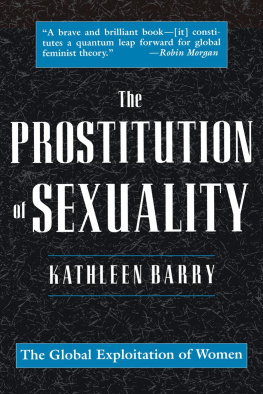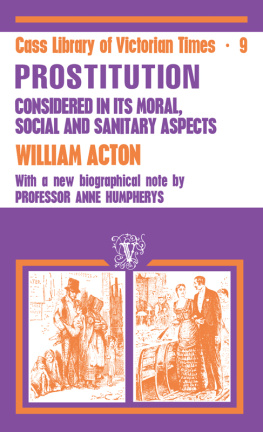Thank you for buying this ebook, published by NYU Press.
Sign up for our e-newsletters to receive information about forthcoming books, special discounts, and more!
Sign Up!
About NYU Press
A publisher of original scholarship since its founding in 1916, New York University Press Produces more than 100 new books each year, with a backlist of 3,000 titles in print. Working across the humanities and social sciences, NYU Press has award-winning lists in sociology, law, cultural and American studies, religion, American history, anthropology, politics, criminology, media and communication, literary studies, and psychology.
The Prostitution of Sexuality
NEW YORK UNIVERSITY PRESS
New York and London
Copyright 1995 by Kathleen Barry
All rights reserved
Library of Congress Cataloging-in-Publication Data
Barry, Kathleen.
The prostitution of sexuality / Kathleen Barry.
p. cm.
Includes bibliographical references (p. ) and index.
ISBN 0-8147-1217-7 (cloth : acid-free paper) ISBN 0-8147-1277-0 pbk.
1. Prostitution-Moral and ethical aspects. 2. Sex oriented
businesses. 3. Sex crimes. 4. WomenCrimes against. 5. Feminist
theory. I. Title.
HQ117.B37 1995
306.74dc20 94-27897
CIP
New York University Press books are printed on acid-free paper,
and their binding materials are chosen for strength and durability.
Manufactured in the United States of America
10 9 8 7 6 5 4 3 2
PREFACE TO EBOOK EDITION
Following the publication of Female Sexual Slavery in 1979, I wrote The Prostitution of Sexuality in 1995 to expose the violent, degrading, exploitative sex that men buy in prostitution, a finding that has since been revealed in recent prostitution survivors' testimonies and the research of Dr. Melissa Farley on men who buy sex. That such sex, through pornography especially, has become normalized, finding its way into bedrooms, relationships, and developing teen sexuality, this book made clear.
With the 2012 release of ebook editions of The Prostitution of Sexuality, I can report that not much has changed about the normalization of prostitution sex. Certainly there has been a wider and more uncontrollable diffusion of pornography via the Internet. And many practices of female sexual slavery are no longer treated as criminal. Readers will find here a remembering of a time not too long ago, when it was considered egregious for white American and European men seeking docile, obedient wives to buy Asian, Russian, and Latin American women. While this was considered trafficking in human beings, it has become so accepted today that mail order bride buying seems to many to be just another version of on-line dating and match-making.
The most important change since I originally wrote this book is the vitality and global reach of the feminist movement to abolish prostitution. It challenges customer demand and is winning legal changes in prostitution laws that result in the arrest, jailing, and fining of customers. Initially prompted by this book, this abolitionist movement is likewise demanding support programs for prostituted women.
Feminist activism to abolish prostitution originated in Sweden under the leadership of lawyer Gunilla Ekberg, then a government minister, and has resulted in what is now a tried and tested law that prohibits the purchase of sexual services. Buying prostitution is considered violence against women under the law that took force in 1999 as part of the Swedish Violence Against Women Act. Within ten years of its enactment, due to arrests of customers, prostitution has been halved in Sweden. In November 2008, Norway criminalized sex purchasing, as did Iceland in April 2009. In 2012 the law has come before the Knesset in Israel, and in several more countries campaigns to abolish prostitution are under way. The French Minister of Women's Rights announced in early 2012 that she is launching a campaign to abolish prostitution not only in France but in all of Europe. With the French campaign the abolitionist movement is making the first moves beyond the state-by-state approach ending prostitution.
State campaigns, whether they involve states within the United States or nation states around the world, are necessary to begin the abolition of prostitution where it is located. But they will always remain only partial victories that leave many women in unaffected states vulnerable to prostitution-particularly the poor, and particularly those in the developing world. The abolitionist movement must be at once local and global, national and international. We have understood the necessity of this strategy since women in the U.S. found that they would not be able to get the right to vote for everyone one state at a time. We needed a constitutional amendment. Likewise, that is why the U.S. required the federal Civil Rights Act of 1965, to extend rights to minorities and women in those states that had refused equality for all.
The best place to start the international campaign for abolishing prostitution is with the Convention Against Sexual Exploitation (see Appendix here), which is a treaty that when signed and enacted by nation states, establishes a new human right-to live free of sexual exploitation in all of its forms. It requires penalties against those who sexually exploit another whether through rape, sexual harassment, prostitution, or pornography, whether in their homes, on the streets, or in the migration process, and whether they are children or adults. I welcome this new ebook edition especially for the role it can continue to play in abolishing prostitution around the world.
Kathleen Barry
Santa Rosa, California
September, 2012
Introduction
Sexual exploitation objectifies women by reducing them to sex; sex that incites violence against women and that reduces women to commodities for market exchange. Sexual exploitation is the foundation of womens oppression socially normalized. This is a difficult and painful subject to study. I tried to back away from this painfulness when I wrote Female Sexual Slavery. I said then:
When a friend first suggested that I write a book on what I was describing to her as female sexual slavery, I resisted the idea. I had gone through the shock and horror of learning about it in the late 1960s when I discovered a few paternalistically written books documenting present-day practices. During that same period I found a biography of Josephine Butler, who single-handedly raised a national and then international movement against forced prostitution in the nineteenth century but who is now virtually unknown. I realized that Josephine Butlers current obscurity was directly connected to the invisibility of sex slavery today. And so I wrote a few short pieces on the subject and incorporated my limited information into the curriculum of the womens studies classes that I taught.
But to write a book on the subjectto spend 2 or 3 years researching, studying female slaverythat was out of the question. I instinctively withdrew from the suggestion; I couldnt face that. But as the idea settled over the next few weeks, I realized that my reaction was typical of womens response: even with some knowledge of the facts, I was moving from fear to paralysis to hiding. It was then that I realized, both for myself personally and for all the rest of us, that the only way we can come out of hiding, break through our paralyzing defenses, is to know the full extent of sexual violence and domination of women. It is knowledge from which we have pulled back, as well as knowledge that has been withheld from us. In








